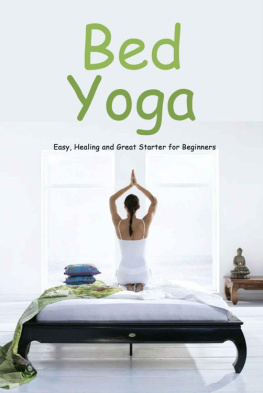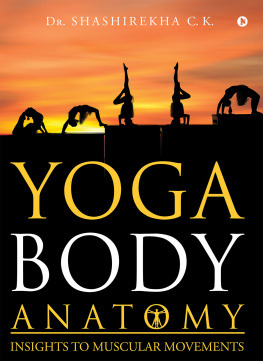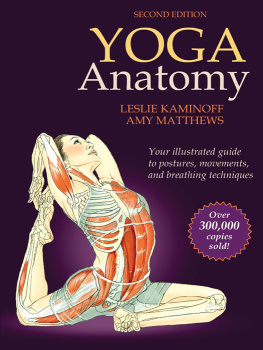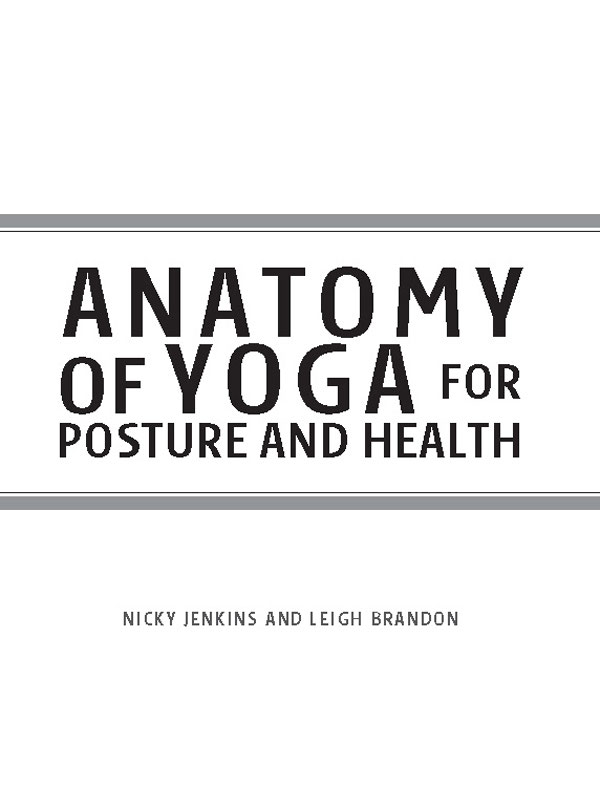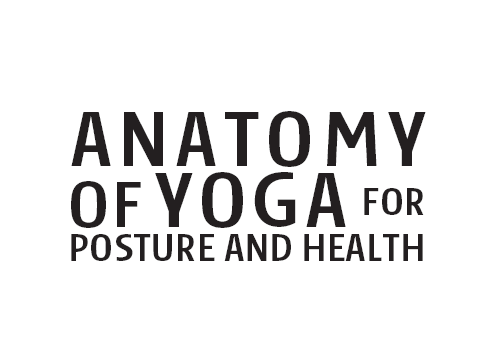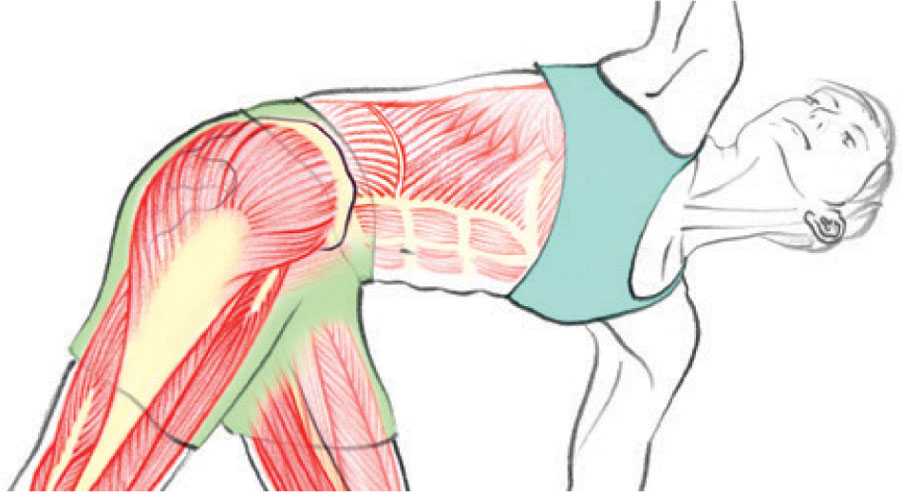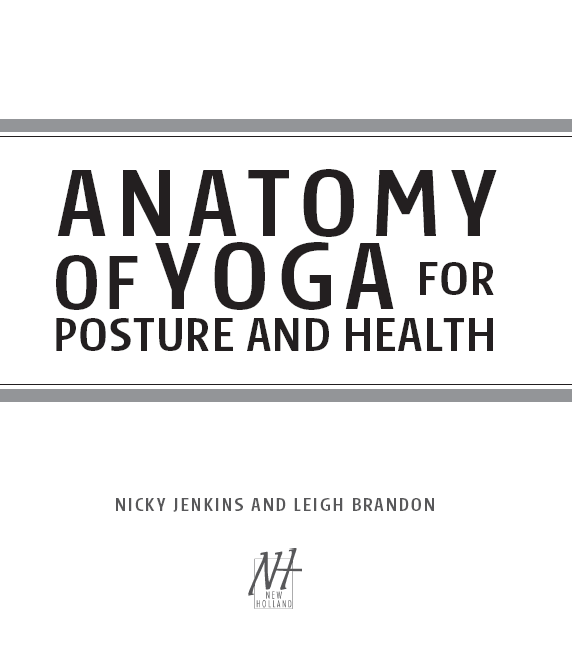CONTENTS
How to Use This Book
PART OVERVIEW OF ANATOMY
Anatomical Definitions and Terminology
Systems of the Body
Body Planes and Regions
Anatomical Terms
Joint Movements
Posture and Muscle Balance
The Spine
Overview of Postural Problems
How Can Yoga Improve Posture?
The Biomechanics of Breath
The Functions of the Diaphragm
The Synergy of Yoga and Breath
Meditation and its Benefits
The Chakras
The Practice
Sun Salutation Surya Namaskar
PART THE EXERCISES
Posture
Longitudinal Mobilizations
Horizontal Mobilizations
Moving Cats
Shoulder Opener
Shoulder Opener
Shoulder Opener
Shoulder Opener
Seated Twist
Locust Pose
Back Bridge
Camel Pose
Half Shoulderstand
Corpse Pose
Breathing Practice
Meditation Practice
Posture
Forward Bend
Yogic Squat
Front Thigh Stretch
Kneeling Hip Flexor Stretch
Warrior Variation
Hero Pose
Childs Pose
Plank
Leg Drops
Leg Rolls
Corpse Pose
Breathing Practice
Meditation Practice
Posture
Expanded Leg Forward Bend
Intense Side Stretch
Extended Straight Leg Stretch
Warrior Variation
Supine Foot Toe Pose
Boat Pose
Moving Cats
Cobra
Locust Pose
Reclining Twist
Corpse Pose
Breathing Practice
Meditation Practice
Posture
Down Dog
Half Splits
Triangle Pose
Revolved Triangle Pose
Gate Pose
Seated Forward Bend
Boat Pose
Side Plank
Locust Pose
Crocodile Pose
Upward Facing Spread Foot Pose
Corpse Pose
Breathing Practice
Mindfulness of Breathing Meditation
Reading
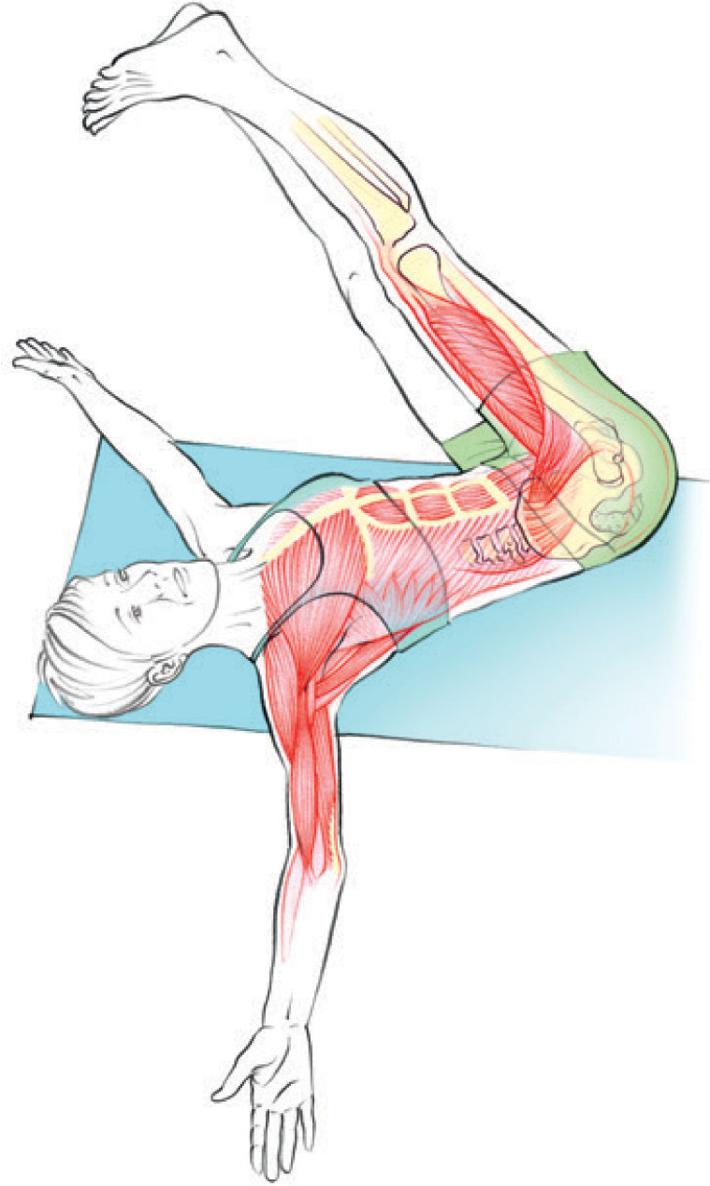
HOW TO USE THIS BOOK
Anatomy of Yoga for Posture and Health is a visual and textual analysis of yoga poses, as well as a guide on how to perform the poses and how to safely and effectively improve your posture and your health. The book has two distinct parts: the first is a basic introduction to anatomical definitions, terminology and an overview of posture, meditation, breath and the chakras. Essentially it helps to demystify the language used in part two, making it easier to follow the instructions in that section. Part two contains four sections: section one covers kyphotic posture, section two covers lordotic posture, section three covers the flat-back posture and section four covers the sway posture. Within each section are five sub-sections: the first covers the potential physical and emotional causes of the particular posture; the second focuses on the related chakra imbalances that may arise; the third section is the sequence of poses, where the individual poses are defined; and the fourth and fifth sections cover a breathing practice and a meditation practice. There is a how to guide for performing the poses in a sequence, as well as a visual and technical analysis of which muscles are being stretched and which muscles are active. The pose is depicted and technique tips are also included.
This book has been designed to help improve your posture and increase your vitality and health. Each pose has been specifically chosen to create balance within each postural type, so it is advisable to follow the sequence as it is shown. To understand which postural type you fall into (if any), have a trained professional assess your posture this could be a physiotherapist, chiropractor, CHEK practitioner or a yoga teacher who has an understanding of postural imbalances. The four postures we have illustrated show the more advanced stages of postural deviation. Due to most peoples day-to-day lives, many of us will suffer from some of these imbalances, but not to the same extreme. The sequences depicted in this book will assist in preventing further imbalances from occurring, and help to bring back muscular balance. When approaching the improvement of our posture, we must also look to enhance both our spiritual and emotional connection to our body. Through exploring the chakras and the possible emotional holding patterns, we can look into the root of our physical holding patterns and try to let them go. The breathing and meditation practices will help to bring you to a place of inner stillness and understanding, bestowing upon you an inner strength that will manifest itself in confidence and the ability to stand tall.
The adult human body has muscles and bones; this book illustrates many of the muscles involved in activation and stretching. Many smaller muscles, including the deep, small muscles of the spine and jaw and most muscles of the hands and feet are not given specific attention.
Disclaimer: the poses have a small degree of risk of injury if done without adequate instruction and supervision. We recommend that you begin with the easier modified poses, and that you seek qualified instruction if you are a complete beginner. This book does not constitute medical advice and the author and publisher cannot be held liable for any loss, injury or inconvenience sustained by anyone using this book or the information contained in it.

PART OVERVIEW OF ANATOMY
ANATOMICAL DEFINITIONS AND TERMINOLOGY
Anatomy has its own language and, whilst technical, it has a basis in logic, originating from the Latin and Greek root words that make it easier to learn and understand the names of muscles, bones and other body parts. Whether youre a yoga instructor or student, using the correct terminology enables you to interact with other professionals and professional materials.
Like most medical terms, anatomical terms are made up of small word parts, known as combining forms, that fit together to make the full term. These combining forms comprise roots, prefixes and suffixes. Knowing the different word parts allows you to unravel the word. Most anatomical terms contain only two parts: either a prefix and root or a root and suffix.
For example, if you take the terms subscapular and suprascapular, the root is scapula, commonly known as the shoulder blade. Supra means above, hence suprascapula means something above the shoulder blade, and sub means below indicating, in this instance, something below the shoulder blade.
Common prefixes, suffixes and roots of anatomical terms
terms
terms terms terms terms terms terms terms
terms terms terms terms terms terms


